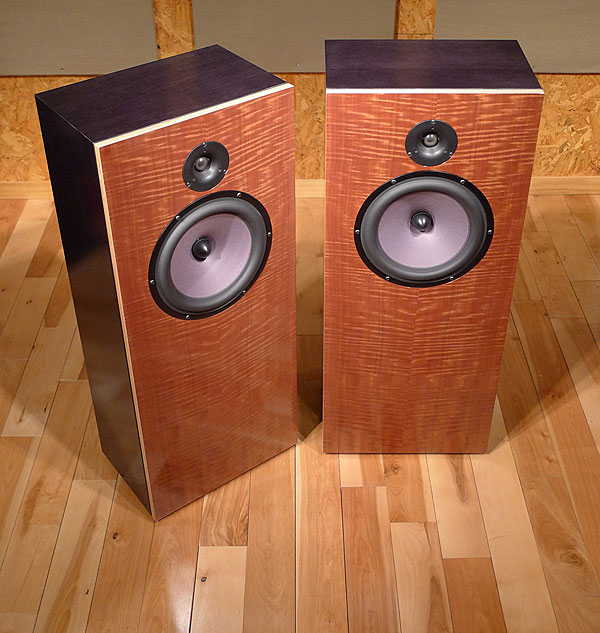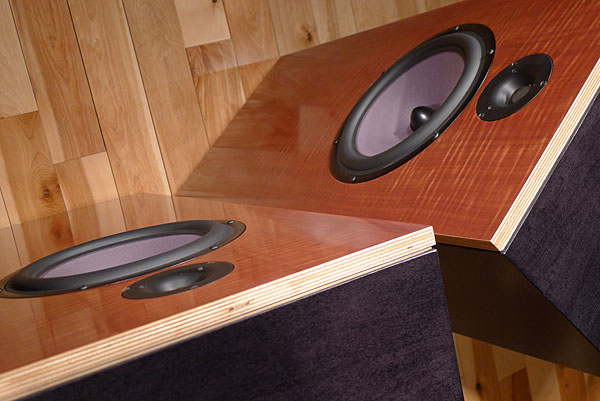| Columns Retired Columns & Blogs |
Why is this just a B rated speaker?
When I review audio gear, I've found that it's always wise to finish by returning to where I started.
I put the GoldenEar Triton Fives and Simaudio Moon Neo 340i integrated amplifier aside, and returned to my reference Line Magnetic LM-518IA and trusty DeVore Fidelity Orangutan O/93s ($8400/pair). Playing Cou$ins Presents . . . A Tribute 2 Studio One & Treasure Isle Records (LP, Cou$ins COUDLP037), I felt I was listening via Studio One's paper-coned monitor speakers. I was immediately struck by how much raw Jamaicanness appeared in my room. Wooden drumsticks slapping snare rims sounded distinctly more real and tangible. Electric-bass harmonics were more fully developed and corporeal. Offbeat rhythms and staccato chords volleyed for my attention. Percussion harmonics became suddenly visible.

That switch to the four-times-as-expensive DeVores ($8400/pair) put the Triton Fives ($1999.98/pair) in broader perspective. The Orangutan O/93s delivered a martial prowess and an extra-drunk dancing quality that the GoldenEars didn't. With the DeVores, there was more flesh and blood. I played King Arthur, by Henry Purcell, that prodigy of London's Old Pye Street and Devil's Acre, as recorded in 1979 by Alfred Deller and the Deller Consort (LP Harmonia Mundi HMC E200). This work, based on the poem by John Dryden, is neither opera nor play but one of those charming hybrids (semi-operas?) that Purcell and Deller seemed to specialize in, and features kicking horses and ritual sacrifices by the Saxon army. The Purcell was 100% enjoyable via both pairs of speakers, but the DeVores brought something extra—something more corporeal—to the presentation. The GoldenEars generated a big, open, fully constituted London-theatre space, filled with nicely articulated musicians and singers. But compared to the DeVores, the Triton Fives made Deller and his performers seem ghostly, and (strangely) more generalized.
Inarguably, the GoldenEar Triton Fives imaged better than the DeVore Orangutans, but they lacked a measure of the O/93s' punch, texture, and raw drive. Compared to the DeVores, the Tritons sounded a bit dark. The GoldenEars did audiophile-checklist stuff with unquestionable aplomb; the DeVores did dirt, dreads, colored lights on wires, and Red Stripe Jamaican Lager with greater realism. But again, the DeVores cost more than four times as much as the GoldenEars.— Herb Reichert
Herb Reichert compared the DeVore O/93 with the Zu Soul Supreme in June 2016 (Vol.39 No.6):
I hate comparisons, but Stereophile readers seem to love them. I hate comparisons because I loathe left-brain listening. I prefer to feel the music and dream along with it. Comparison means I have to think—maybe even quantify my experiences—and you all know I can't think and make love at the same time. (Can you?)
Actually, I'm not completely right-brain; I do measure the final value of all audio equipment by the quantity of musical connectedness it can provide.
DeVore Fidelity's Orangutan O/93s ($8400/pair) always deliver copious amounts of savory musical connectedness. So did Zu Audio's Soul Supremes. Both are very direct, exciting-sounding loudspeakers. Both are unusually expressive and very non–hi-fi. Both capture musical heartbeats well. Both love high-quality, low-power, class-A amplifiers.
But how, other than in price, do they differ? I suspect the answers lie in their crossover philosophies, their woofer loading, and, especially, the sound character and implementation of their paper cones.

To my ears, every speaker driver sounds like the materials of which its cone or dome is made. Other elements of the driver and the materials they're made of—iron, neodymium, beryllium, alnico, Kevlar, rubber, ceramic, plastic, etc.—also come into play. Each colors the music with its resonant nature—or at least I imagine they do.
As I listened to "Lullaby" from Scott Walker's and Sunn O)))'s Soused (LP, 4AD 73428) through the Line Magnetic LM-518 integrated and DeVore Orangutans, singer Scott Walker sounded less present, fearsome, and tactile than through the Soul Supremes. His voice also sounded much finer grained and relaxed. The DeVores are noticeably smoother through the midrange than the Zus. The Soul Supremes made music sound louder and more direct, with amazingly lifelike macrodynamics. The distance between soft and loud seemed greater through the Zus than through the DeVores. Compared to the Soul Supremes, the Orangutan O/93s capture more microdetail and dynamic nuance, but seem to compress larger dynamic contrasts. Music seemed to flow faster and more forcefully through the Zus—they had an inescapable "wild woman" boogie factor that swept me up and took me for a Cadillac ride to the Promised Land. The DeVores are a different kind of abductor: They seduce me with their saucy smile, barefoot dancing, and sequined Gypsy clothes. Both induce submission to their charms.
To my ears, the biggest difference between these two excellent—but non-mainstream!—speakers was in the voices of their very different magnet and (paper) cone structures. The Zu woofer's voice reminded me just a little of my ancient and beloved Altec 604s: lightning fast, mostly neutral, wide open, and breathy, while the DeVore O/93s deliver a less open but more refined, colorful, and modern sound. What I mean is: the 10" DeVore woofer delivers less dynamic slam, but more nuance and tonal shading.
Sean Casey and John DeVore are both extremely talented designers. I suspect that each made difficult decisions in order to preserve what he believed to be important. Consider me a fan of both aesthetics.— Herb Reichert

Why is this just a B rated speaker?

Why is this just a B rated speaker?
Our ratings are the results of a poll of the magazine's reviewers and editors. With some products, there is a greater consensus than with others.
John Atkinson
Editor, Stereophile


It's gotten runner-up for speaker of the year a few times, but I've noticed the way speakers are classified in the Recommended list hasn't been consistent, either. I have a pair of O/93s, and they're amazing. I don't think what a magazine classifies them as is a final judgement on quality by any means. Much like good booze, or fine wine, I treat these kinds of classifications more like guidelines, with a heavy dose of salt. I personally like the Devores better than Magicos, not because the O/93 is inherently better, it's just a very different kind of sound. And one that's well suited to my taste.

Why is the KEF LS 50 speaker an A rated component. I know which one I would rather have.

There's something about the ports of the Devore O/93 Loudspeaker that can't help but get me thinking about the Flamenco Box...
http://www.lpmusic.com/products/cajons/lp/americana-ambrosia-maple-wire-cajon
Not that the box is the same, but take a look at the Graham Audio LS5/9 Loudspeaker.
They talk about BBC Engineering, but don't tell me that those BBC Engineers didn't just take a slighly smaller than 18 1⁄2"H × 11 1⁄4"W × 11 1⁄4"D cajon (talk about cajons) and add drivers to make it a 11" x 18" x 10.75" speaker. :)
Speaking of which, I'd really like to know how these loudspeakers handle some Gypsy Jazz? :)
Cabinet wise, of course the reminiscence of the O/93 is Audio Note UK AN/E, which is a Snell design? :)
Of the Devores, I think the Gibbon X is really charming!
Nice to see the O/93 used with tube amplification. An Audio Note Japan Ongaku would likely make a wonderful compliment.


Have only heard their smaller monitors...years ago at shows and rather liked them. I think the cabinetry is awesome, and always nice to see local guy doing well.

Is this just an online update on the reviews concerning the O/93 from older articles that were ran in 2014 and 2015? Or is there supposed to be something new that I'm not catching?

Is this just an online update on the reviews concerning the O/93 from older articles that were ran in 2014 and 2015?
Yes, this is Sam's original review, which had not previously been reprinted on our website, plus Herb Reichert's more recent comments so that all our coverage can be found in the same place.
John Atkinson
Editor, Stereophile

John Atkinson,
I wonder if the sense of a suck out or discontinuity Herb mentions might come from sitting closer than ideal to the 0/93s?
I noticed in auditioning them (several times) that they really did alter their character when changing listening distance. They really "snapped in to focus" tonally and imaging-wise once I hit about 8 feet from the speaker, which I believe is the minimum distance recommended by Devore. If I sat closer, the balance started getting somewhat mellow, a bit more discontinuous. In moving closer - e.g. 7 feet or closer - even if the speakers were toed in more toward me to try to maintain the high frequency balance, the speakers still didn't have the focus, air and snap they did once I retreated back to 8 feet and beyond.
Having seen the video of Herb's space, it suggests he must sit fairly close to his speakers.
(BTW, like some of your reviewers, I love the sound of the Devore O series. They have a chunky, rich sound that gives more body to voices and instruments than many other slender designs, IMO).

I am glad that our reviewers have discovered free streaming. It's not the highest of hi-rez. But there are no monthly fees, logins, and all the rest.
To boot, there are almost 9 years of archived programs to be had here. I only wish that BBC Radio 3 would not require PC users to turn the volume almost up to the max to hear the "Lunchtime Concert."
http://www.rtve.es/radio/radioclasica/
After trying the BSO and BBC Radio 3, try Radio Clasica, Radio Nacional de Espana. There's more on offer each day than a person could listen to in a 24-hour day. The "Grandes Ciclos" program, hosted by Eva Sandoval, is already into its second week of a survey over the life and works of Satie.

http://news.harvard.edu/gazette/story/2016/05/boyd-irven-devore-dies-at-79/
When I taught fifth grade social studies long ago, DeVore's work was the basis of a unit on baboon society. The kids and I learned to imitate the various baboon calls. Never try them in a crowded theater!

eagerly anticipated revelations. I look forward to them like I used to look forward to Manny Farber's film reviews in The New Republic (and other publications) back in the day. I don't think people really appreciate his artistry of turning the sounds of reproduced music and his feelings about the impact of those sounds into expressive evocations as sublime as the music itself.

Stop beating around the bush, man! Do you or don't you like Herb's reviews?? :-)

THANK YOU John Atkinson for publishing these measurements!
I've been in interested in the Devore O speakers, especially the 0/93s, and it's helpful to be able to correlate measurements somewhat with my own impressions.

JA - did you ever get over to Herb's to listen to confirm the suck-out? Inquiring minds and all that.